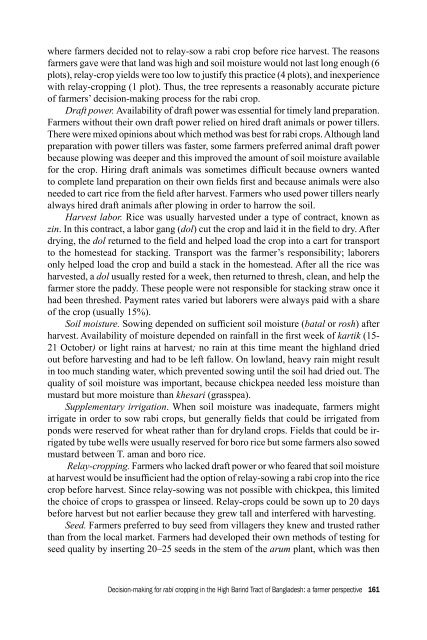Download (2461kB) - University of Greenwich
Download (2461kB) - University of Greenwich
Download (2461kB) - University of Greenwich
- No tags were found...
Create successful ePaper yourself
Turn your PDF publications into a flip-book with our unique Google optimized e-Paper software.
where farmers decided not to relay-sow a rabi crop before rice harvest. The reasonsfarmers gave were that land was high and soil moisture would not last long enough (6plots), relay-crop yields were too low to justify this practice (4 plots), and inexperiencewith relay-cropping (1 plot). Thus, the tree represents a reasonably accurate picture<strong>of</strong> farmers’ decision-making process for the rabi crop.Draft power. Availability <strong>of</strong> draft power was essential for timely land preparation.Farmers without their own draft power relied on hired draft animals or power tillers.There were mixed opinions about which method was best for rabi crops. Although landpreparation with power tillers was faster, some farmers preferred animal draft powerbecause plowing was deeper and this improved the amount <strong>of</strong> soil moisture availablefor the crop. Hiring draft animals was sometimes difficult because owners wantedto complete land preparation on their own fields first and because animals were alsoneeded to cart rice from the field after harvest. Farmers who used power tillers nearlyalways hired draft animals after plowing in order to harrow the soil.Harvest labor. Rice was usually harvested under a type <strong>of</strong> contract, known aszin. In this contract, a labor gang (dol) cut the crop and laid it in the field to dry. Afterdrying, the dol returned to the field and helped load the crop into a cart for transportto the homestead for stacking. Transport was the farmer’s responsibility; laborersonly helped load the crop and build a stack in the homestead. After all the rice washarvested, a dol usually rested for a week, then returned to thresh, clean, and help thefarmer store the paddy. These people were not responsible for stacking straw once ithad been threshed. Payment rates varied but laborers were always paid with a share<strong>of</strong> the crop (usually 15%).Soil moisture. Sowing depended on sufficient soil moisture (batal or rosh) afterharvest. Availability <strong>of</strong> moisture depended on rainfall in the first week <strong>of</strong> kartik (15-21 October) or light rains at harvest; no rain at this time meant the highland driedout before harvesting and had to be left fallow. On lowland, heavy rain might resultin too much standing water, which prevented sowing until the soil had dried out. Thequality <strong>of</strong> soil moisture was important, because chickpea needed less moisture thanmustard but more moisture than khesari (grasspea).Supplementary irrigation. When soil moisture was inadequate, farmers mightirrigate in order to sow rabi crops, but generally fields that could be irrigated fromponds were reserved for wheat rather than for dryland crops. Fields that could be irrigatedby tube wells were usually reserved for boro rice but some farmers also sowedmustard between T. aman and boro rice.Relay-cropping. Farmers who lacked draft power or who feared that soil moistureat harvest would be insufficient had the option <strong>of</strong> relay-sowing a rabi crop into the ricecrop before harvest. Since relay-sowing was not possible with chickpea, this limitedthe choice <strong>of</strong> crops to grasspea or linseed. Relay-crops could be sown up to 20 daysbefore harvest but not earlier because they grew tall and interfered with harvesting.Seed. Farmers preferred to buy seed from villagers they knew and trusted ratherthan from the local market. Farmers had developed their own methods <strong>of</strong> testing forseed quality by inserting 20–25 seeds in the stem <strong>of</strong> the arum plant, which was thenDecision-making for rabi cropping in the High Barind Tract <strong>of</strong> Bangladesh: a farmer perspective 161
















